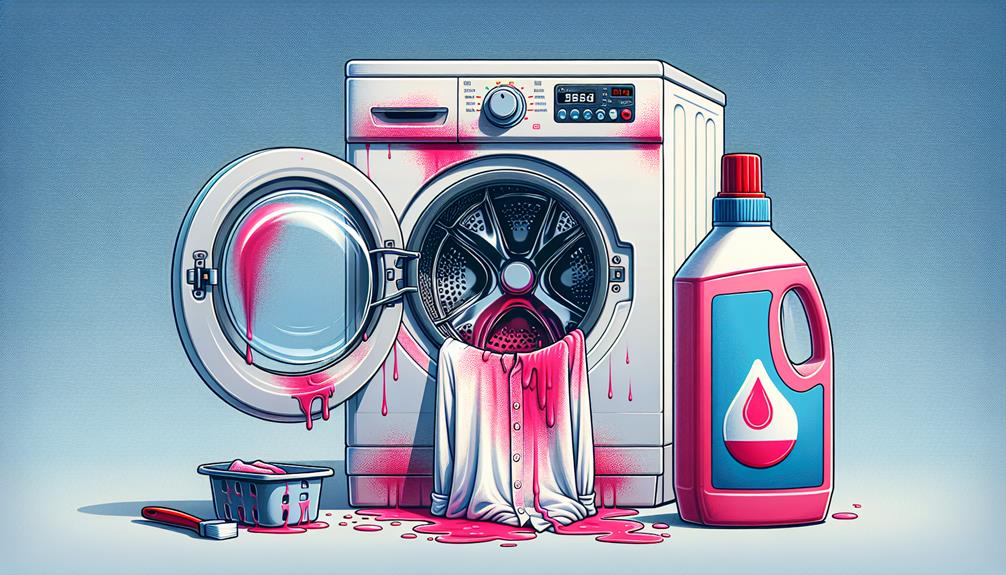When tackling the task of removing color bleed out of clothes, the process can seem perplexing at first. However, with proper techniques and a bit of patience, achieving successful results is plausible.
From utilizing household items like vinegar to employing oxygen-based bleach for stubborn stains, there's a plethora of methods to explore.
Stay tuned to discover the most effective ways to salvage your favorite garments and restore them to their former glory.
Table of Contents
Key Takeaways
- Sort clothes by color and fabric to prevent color bleed
- Use color catchers and pre-wash new clothing
- Soak in detergent or use vinegar for natural remedy
- Employ oxygen-based bleach or commercial color remover for tough stains
Understanding Color Bleed
Understanding color bleed starts with recognizing the potential for dye transfer between fabrics during the washing process. When clothes with different colors are washed together, especially if the water temperature is high, the dyes can mix and bleed from one fabric to another. This results in unwanted stains that can be challenging to remove. Dark and bright colors are more prone to bleeding, so paying attention to the color intensity when sorting laundry is vital.
To effectively tackle color bleed stains, acting promptly is key. The sooner you address the issue, the better your chances of successful stain removal. One effective method is to rewash the affected garment using cold water and a color-safe detergent. Cold water helps prevent further bleeding, and a specialized detergent formulated to lock in colors can aid in lifting the stains. Additionally, treating the stained area with a stain remover before rewashing can enhance the likelihood of completely removing the bleed.
Prevention Techniques
To prevent color bleed incidents, I always make sure to sort my clothes by color and fabric type before tossing them in the washing machine. This simple step can go a long way in preserving the vibrancy of your garments and preventing unwanted color transfers.
Here are three key prevention techniques I swear by to keep color bleed at bay:
- Use color catchers: These nifty sheets trap loose dyes in the water, preventing them from seeping into other fabrics during the wash cycle.
- Pre-wash new clothing: It's crucial to pre-wash new clothing items to remove any excess dye that may bleed out during the first wash. This preemptive measure can save your other clothes from staining.
- Follow care labels: Always adhere to the care instructions on your garments. These labels provide specific guidance on how best to wash and care for your clothes, minimizing the risk of color bleed incidents.
Removing Color Bleed
I've discovered some effective ways to tackle color bleed on clothes. Soaking them in a laundry detergent solution, using vinegar as a natural remedy, and resorting to oxygen-based bleach for tough stains are all viable options.
Additionally, hydrogen peroxide can work wonders on dye transfer stains, and following specific instructions from commercial color removers can help prevent color bleed in the future.
Color Bleed Causes
Color bleed in clothes typically occurs as a result of ineffective dyeing techniques or improperly set dyes in fabrics. When dealing with color bleed, it's important to understand the underlying causes to prevent future incidents effectively.
Here are some key factors contributing to color bleed in clothes:
- Garment Color: Orange and red hues are more likely to bleed onto lighter clothes due to their vibrant pigments.
- Fabric Quality: Overdyed fabrics or those with low-quality dyes are prone to unexpected color transfers during washing.
- Separate Washing: Washing orange-red items separately can help prevent color bleeding accidents and preserve the integrity of your white clothes.
Effective Removal Methods
When dealing with color bleed on clothes, soaking them in a laundry detergent solution can effectively loosen stains. For white items, hydrogen peroxide is a powerful ally in removing dye transfer stains.
Oxygen-based bleach is a great option for colored garments with tougher color transfer stains. If the color bleed stains persist, consider using commercial color remover solutions, following the instructions meticulously.
Vinegar can also be used as a natural remedy to help lift color bleed from fabrics. By choosing the appropriate method based on the type of fabric and color bleed, you can effectively remove the unwanted hues and restore your clothes to their original vibrancy.
Preventing Future Incidents
To prevent future color bleed incidents, it's important to sort clothes by color and fabric type before washing. This practice helps avoid color transfer and potential bleeding between garments.
Additionally, using color catchers in the laundry can trap loose dyes, preventing them from affecting other clothing items. Pre-washing new clothes separately is also essential to remove any excess dye that could cause bleeding during regular washing cycles.
Following the care labels on garments for specific washing instructions further aids in preventing color bleed mishaps. By separating colors, using color catchers, and pre-washing new items, you can effectively mitigate the risk of color bleed and maintain the vibrancy of your clothes.
Bleach and Vinegar Methods
For tackling color bleed on clothes, a powerful method involves using either bleach or vinegar, depending on the fabric's color and type. When dealing with color bleed on white clothes, chlorine bleach is highly effective in removing stains. On the other hand, vinegar serves as a natural and safe alternative for colored garments. Additionally, commercial color removers are available for stubborn stains. Always remember to check the care labels on your clothes before using bleach or vinegar to prevent damage. Acting promptly is crucial when treating color bleed stains to avoid them setting in and becoming harder to remove. Below is a table summarizing the key points for using bleach and vinegar methods:
| Method | Fabric Type |
|---|---|
| Bleach | White clothes |
| Vinegar | Colored clothes |
| Commercial Removers | Stubborn stains |
| Prompt Action | Prevents setting |
Caring for Affected Clothes
Taking care of clothes affected by color bleed requires gentle handling and specific precautions to prevent further damage. When dealing with color bleed stains, it's important to follow these steps:
- Avoid High Heat: To prevent the stain from setting further, refrain from using high heat when drying color-bleed affected clothes. Opt for air-drying or use a low-heat setting in the dryer.
- Separate Affected Clothes: Stop the spread of color and prevent additional staining by keeping the affected clothes separate from others during the washing and drying process. This helps contain the issue and avoids ruining other garments.
- Use Color Catcher Sheets: Incorporate color catcher sheets in the dryer to absorb any remaining dye and protect other garments from potential color transfer. These sheets can help salvage affected clothes and maintain the integrity of your wardrobe.
Avoiding Color Bleed in the Future
I've learned that sorting clothes by color and fabric type, using color catchers, and pre-washing new items can help prevent color bleed in future laundry loads.
Following care labels and washing dark and light colors separately are essential precautions to maintain color integrity and avoid potential bleed incidents.
These simple steps like color separation, washing precautions, and proper garment sorting are key to preventing color bleed and keeping clothes looking vibrant.
Color Separation Tips
How can you prevent color bleed in your future laundry loads? Here are some color separation tips to help you avoid color bleed mishaps:
- Sort your laundry: Separate whites, darks, and colors to prevent bleeding. Additionally, sort by fabric type to avoid damage or color transfer.
- Use color catchers: These sheets trap loose dyes in the wash, preventing them from transferring to other garments. They're especially useful when washing mixed loads.
- Pre-wash new clothing: Before wearing or washing new items, pre-wash them separately to remove any excess dye that may cause bleeding in subsequent washes. This simple step can help preserve the colors of your other garments.
Washing Precautions Guide
To avoid color bleed in future laundry loads, follow these washing precautions.
When washing colored clothes, always separate darks from lights to prevent color bleeding. Check fabric types and care labels for specific washing instructions. Consider using color catchers in the laundry to trap loose dyes and avoid color transfer.
Before wearing new colored garments, pre-wash them to remove any excess dye that may bleed during the first wash. By following these steps and taking care when washing your colored clothes, you can guarantee color bleed incidents and preserve the longevity of your garments.
Sorting Garments Properly
Why must we always sort clothes by color and fabric type before washing to prevent color bleed incidents? It's essential to follow these steps to avoid any mishaps in the laundry:
- Use Color Catchers: These handy laundry sheets trap loose dyes, preventing them from transferring onto other garments.
- Pre-wash New Clothes: By pre-washing new items, you can remove excess dye that may bleed onto other clothes during the first wash.
- Follow Care Labels: Pay close attention to the specific washing instructions on care labels. This will help you avoid color transfer and bleeding, ensuring your clothes remain vibrant and stain-free.
Frequently Asked Questions
How Do You Get Color Transfer Out of Clothes?
To remove color transfer from clothes, I soak them in an oxygen-based bleach solution before rewashing with detergent. Prevent dye stains by sorting laundry by color and fabric type. Avoid machine drying stained items to avoid setting the stain.
Can You Fix Color Bleeding on Clothes?
I can fix color bleeding on clothes by treating them immediately. Identifying and removing the culprit is important to prevent further staining. Rewashing with detergent and oxygen bleach helps remove stains. Following garment labels prevents color bleeding.
How Do You Remove Color Run From Clothes?
To remove color run from clothes, I tackle stains with vinegar or laundry detergent solution. For stubborn marks, oxygen bleach helps lift dye. Hydrogen peroxide is ideal for whites. Always follow product instructions. These methods effectively combat color bleed on clothes.
Can Baking Soda Remove Color Bleed?
Yes, baking soda can remove color bleed from clothes. I create a paste with baking soda and water, apply it to the affected area, scrub gently, let it sit, and rinse. Repeat if needed until the color bleed is gone.
- Do Levi’s Corduroys Shrink? Understanding Fabric Care Tips - July 4, 2025
- Silencing Corduroy Jeans: Tips to Reduce Noise When Wearing Them - July 4, 2025
- Understanding Pinwale Corduroy: A Fabric Guide for Designers - July 4, 2025







